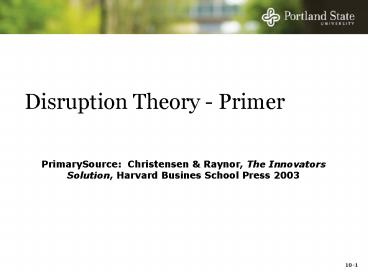Disruption Theory - Primer - PowerPoint PPT Presentation
1 / 9
Title:
Disruption Theory - Primer
Description:
Managers become risk adverse and avoid uncertain new-growth ventures ... It is much easier to beat competitors when they are motivated to flee rather than fight1 ... – PowerPoint PPT presentation
Number of Views:168
Avg rating:3.0/5.0
Title: Disruption Theory - Primer
1
Disruption Theory - Primer
- PrimarySource Christensen Raynor, The
Innovators Solution, Harvard Busines School Press
2003
2
Growth Perceptions vs. Research
Academic Research
Growth Misconceptions
- The solve-the-problem-by-finding-a-better-manager
approach might have credence if failures to
restart growth were isolated events.1 - Many who have been unable to sustain growth have
taken huge risks.1 - In study after study, employees were able to
identify new growth opportunities but companies
chose to act on the wrong ones.1
- Managers are to blame more capable people would
have succeeded - Managers become risk adverse and avoid uncertain
new-growth ventures - New technologies sneak up on companies who are
unaware - Employees are unable to identify new growth
businesses as they emerge
What causes these misconceptions? Why is
profitable growth so hard to sustain?
1. The Innovators Solution Creating and
Sustaining Successful Growth. Clayton
Christensen Michael Raynor. HBS Press, Boston,
2003.
3
The Innovators Dilemma
Desire to Maintain High Margins
Threat of Potential Disruptions
Moving businesses toward higher-margin products
and shedding less-profitable products at the
low-end is something that good managers do in
order to increase profits however, this also
opens the door to disruption.1
Sustaining innovations are so important and
attractive, relative to disruptive ones, that the
very best sustaining companies systematically
ignore disruptive threats and opportunities until
it is too late.1
Innovators Dilemma
- Should we invest to protect the least profitable
end of our business, so that we can retain our
least loyal, most price-sensitive customers? - Or should we invest to strengthen our positing in
the most profitable tiers of our business, with
customers who reward us with premium prices for
better products?
1. The Innovators Solution Creating and
Sustaining Successful Growth. Clayton
Christensen Michael Raynor. HBS Press, Boston,
2003.
4
Disruptive Technologies
- The Innovators Solution Creating and Sustaining
Successful Growth. Clayton Christensen Michael
Raynor. HBS Press, Boston, 2003.
The Innovators Solution Creating and Sustaining
Successful Growth. Clayton Christensen
Michael Raynor. HBS Press, Boston, 2003.
5
Innovation Management
- Sustaining Innovations
- Making better products that can be sold for more
money to attractive customer bases - Sustaining innovations are required to stay
competitive and should be aggressively pursued
Industry incumbents almost always prevail
- Disruptive Innovations
- New products that are not as good as currently
available products, but that are typically
simpler, more convenient, and less expensive
products that appeal to new or less-demanding
customers.1
New-market entrants almost always beat incumbents
1. The Innovators Solution Creating and
Sustaining Successful Growth. Clayton
Christensen Michael Raynor. HBS Press, Boston,
2003.
6
Asymmetric Motivations Steel Industry
- Up-market Minimill Migration
- Historically, most steel came from massive
integrated mills that molten ore, roll and finish
steel - Minimills became disruptive to integrated mills
by targeting the low-end and migrating upward - Minimills melt scrap metal in small electric
furnaces yields 20 cost advantage - Since minimills began by targeting low-end rebar
(4 of market, with only 7 margins), integrated
mills felt little pain initially
Source The Innovators Solution
1. Continuous Casting Investments at USX
Corporation. Clayton Christensen. HBS No.
9-697-020.
7
The Innovators Solution
- Research Insight
- When a company tries to take a higher-cost
business model down-market to sell products at
lower price points, almost none of the
incremental revenue falls to the bottom line. - When companies move up-market to make
higher-performance products that sell at higher
price points, much of the incremental margin
falls to the bottom line.1 - Innovators Solution
- Target products and markets that the incumbents
are motivated to ignore or run away from. - Established firms that hope to capture the growth
created by disruption need to do so from within
an autonomous business with a cost structure that
offers as much headroom as possible for
subsequent profitable migration up-market.1
In the history of the disk-drive industry, every
company that has tried to manage mainstream and
disruptive businesses within a single
organization failed.2
1. The Innovators Solution Creating and
Sustaining Successful Growth. Clayton
Christensen Michael Raynor. HBS Press, Boston,
2003. 2. Disruptive Technologies Catching the
Wave. Joseph Bower Clayton Christensen. HBR
Jan-Feb 1995.
8
Creating New-Growth Businesses
Leaders Ignore
- New-Market Disruptions
- Create a new value network, where it is
non-consumption is targeted, not the incumbent - As performance improves, new market disruptors
eventually pull customers out of the original
value network into the new one
Because new-market disruptions target
non-consumption, market leaders feel little pain
until...1
Leaders Flee
- Low-End Disruptions
- Low-end disruptions simply use low-cost business
models that grow by picking off the least
attractive customers - Examples Steel minimills, discount retailers
Low-end disruptions motivate incumbents to flee.
It is hard for established firms not to flee from
low-end disruptors.1
It is much easier to beat competitors when they
are motivated to flee rather than fight1
1. The Innovators Solution Creating and
Sustaining Successful Growth. Clayton
Christensen Michael Raynor. HBS Press, Boston,
2003.
9
Disruption Theory
Sustaining Incumbent Succeed
Sustaining New Entrant Fail
Disruptive Low End New Market Incumbent Succeed (ONLY with enough autonomy)
Disruptive Low End New Market New Entrant Succeed
The Innovators Solution Creating and Sustaining
Successful Growth. Clayton Christensen
Michael Raynor. HBS Press, Boston, 2003.

